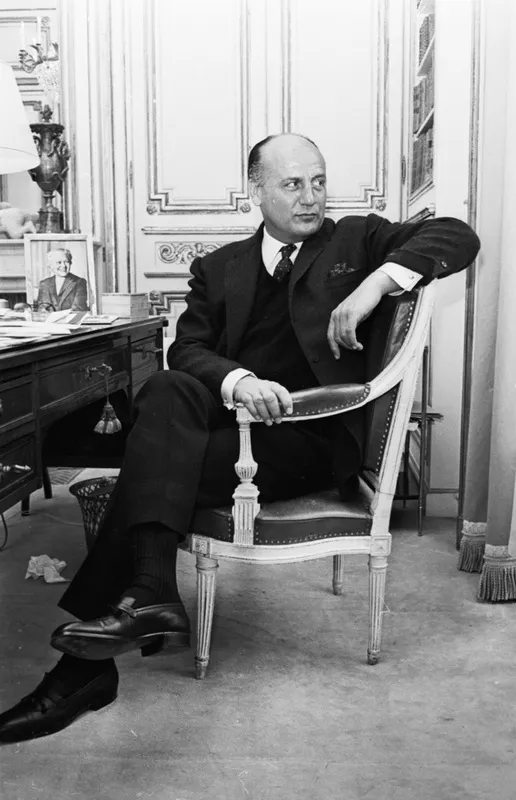
When you think of French elegance and sophistication, one name undoubtedly stands out: Pierre Balmain. Renowned for his transformative impact on haute couture, Pierre Balmain brought a sense of unparalleled elegance to post-war France. His fashion house became a sanctuary for creativity, redefining how women expressed themselves through clothing. With an enduring reputation for opulence, craftsmanship, and timeless design, the Pierre Balmain brand continues to thrive decades after its founding, proving that true style is eternal.
Table of Contents
The Early Life of Pierre Balmain
Pierre Balmain was born on May 18, 1914, in the serene town of Saint-Jean-de-Maurienne, nestled in the French Alps. His childhood was shaped by a rich family heritage steeped in textiles and artistry. His father, a drapery business owner, and his mother, a fashion boutique manager, unknowingly planted the seeds of his future career. Though his early life was grounded in this creative environment, Pierre initially pursued architecture at the prestigious École des Beaux-Arts in Paris. However, the pull of fashion was undeniable, leading him to abandon his studies to follow his true passion.
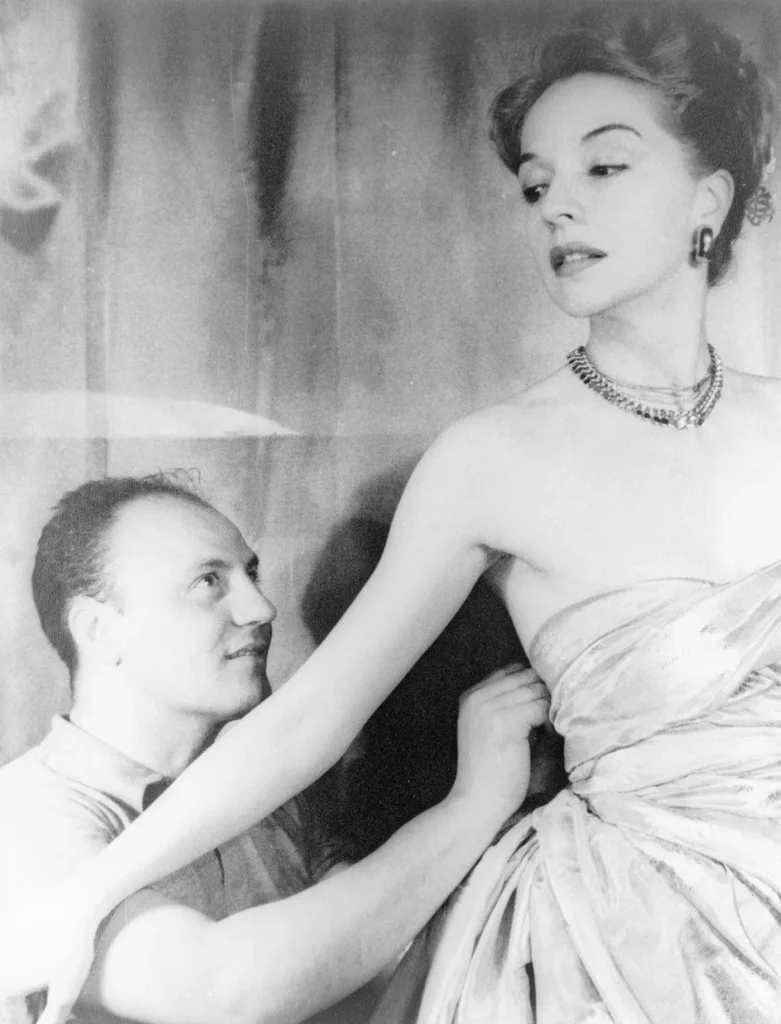
photo/britannica
Founding of the Balmain Fashion House
Establishment of Maison Balmain in 1945
The end of World War II marked the birth of a new era in fashion, and Pierre Balmain seized this opportunity by founding Maison Balmain in Paris in 1945. His vision was clear: to create clothing that celebrated elegance, femininity, and the joys of life. His inaugural collection introduced silhouettes that exuded grace and luxury, a stark contrast to the utilitarian wartime garments that had dominated the previous years. Balmain’s designs resonated with women yearning for beauty and sophistication, firmly establishing his brand as a beacon of hope and glamour.
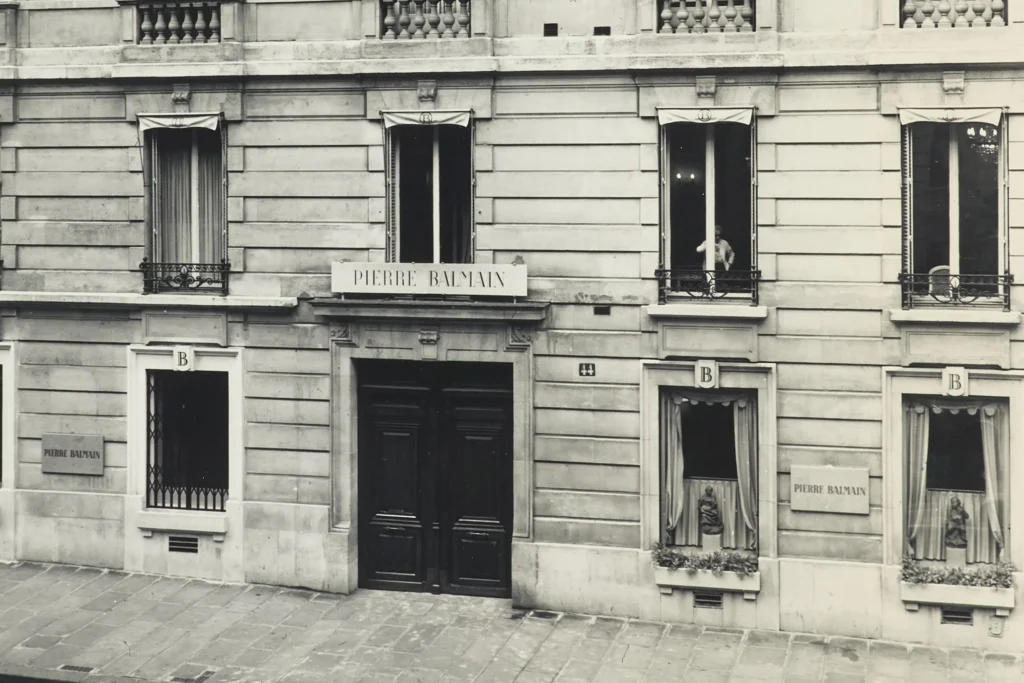
photo/balmain
Early Collections
Balmain’s early collections were a revelation. His debut designs featured tailored jackets, cinched waists, and flowing skirts that highlighted the female form. These creations captured the imagination of fashion critics and the public alike, earning him immediate acclaim. Each piece reflected his meticulous attention to detail and his dedication to craftsmanship, setting a standard for haute couture that others aspired to meet.
Design Philosophy
Pierre Balmain’s design philosophy was rooted in his belief that fashion should embody timeless elegance and empower its wearers. He coined the term “Jolie Madame,” a style that celebrated femininity, grace, and sophistication. Balmain’s designs focused on clean lines and structured silhouettes, often incorporating luxurious fabrics such as silk, velvet, and fine wools. He avoided excessive embellishments, favoring subtle details that enhanced the overall aesthetic without overwhelming it.
This minimalist approach allowed his clothing to transcend fleeting trends, appealing to women across generations. Balmain believed that true beauty lay in simplicity, and his work reflected a perfect harmony of form, function, and artistry. His philosophy remains a cornerstone of the brand’s identity, influencing modern designs that blend heritage with innovation.
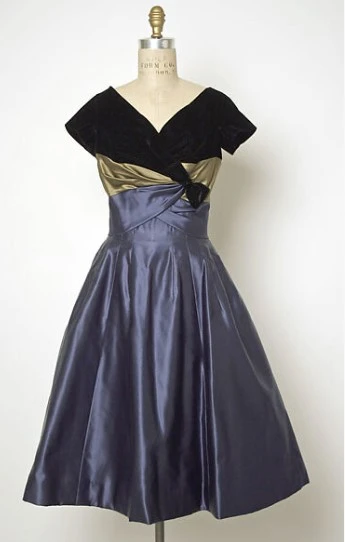
photo/metmuseum
Notable Collection and Work
The “Jolie Madame” Collection
One of Pierre Balmain’s most celebrated collections was the “Jolie Madame,” which debuted in the late 1940s. This collection epitomized Balmain’s design ethos, featuring tailored suits, cinched waists, and flowing skirts that flattered the female form. It was a direct response to the austerity of wartime fashion, offering women a chance to rediscover elegance and grace. The “Jolie Madame” style became synonymous with post-war glamour, influencing countless designers and solidifying Balmain’s status as a trailblazer in haute couture.

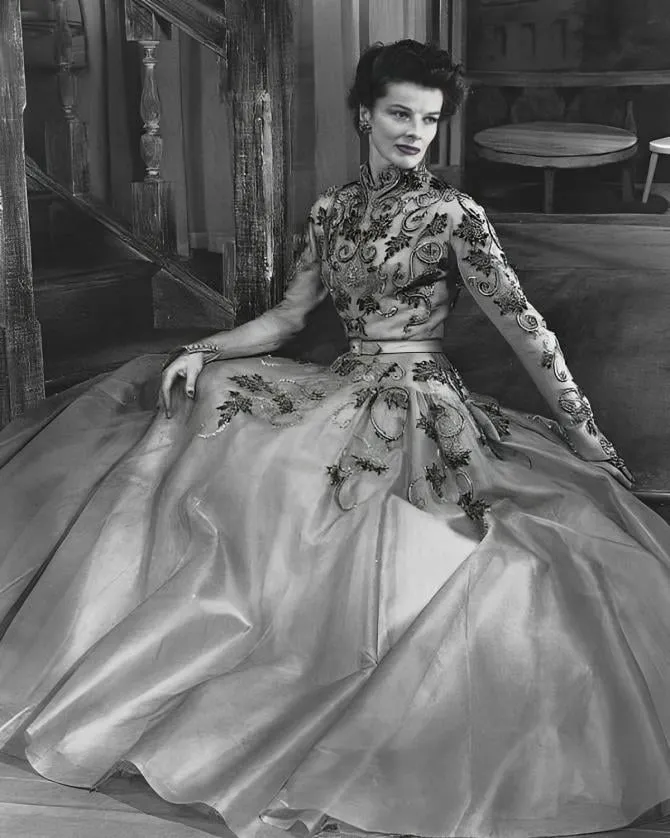
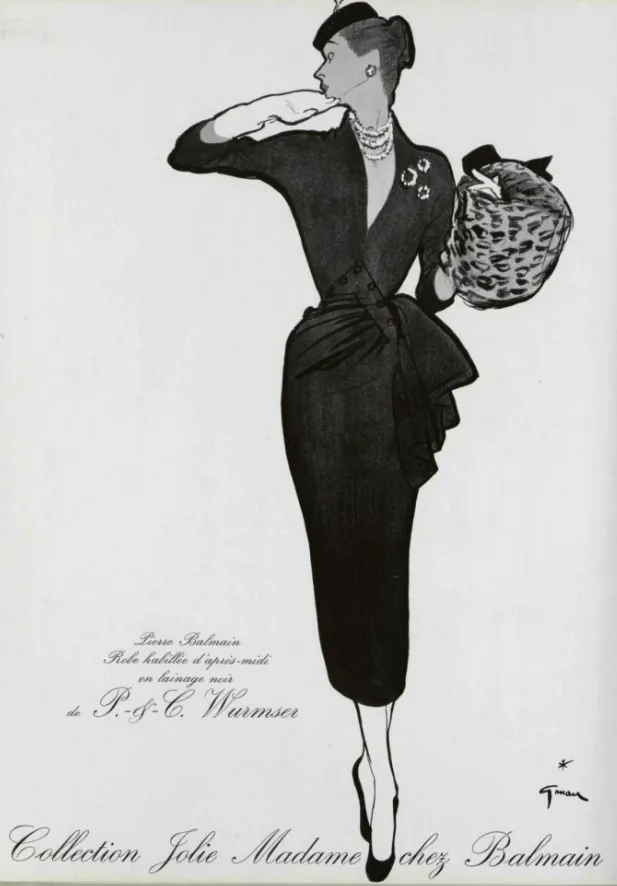
photo/africa ird/reddit/icon icon
Couture for Royalty and Celebrities
Balmain’s clientele included some of the most influential figures of his time. He designed wardrobes for Queen Sirikit of Thailand, crafting exquisite ensembles that reflected her regal status while incorporating elements of Thai culture. Hollywood stars like Marlene Dietrich and Sophia Loren also adored his work, frequently donning his gowns for premieres and award ceremonies. Each piece was tailored to perfection, showcasing Balmain’s ability to merge artistry with functionality.
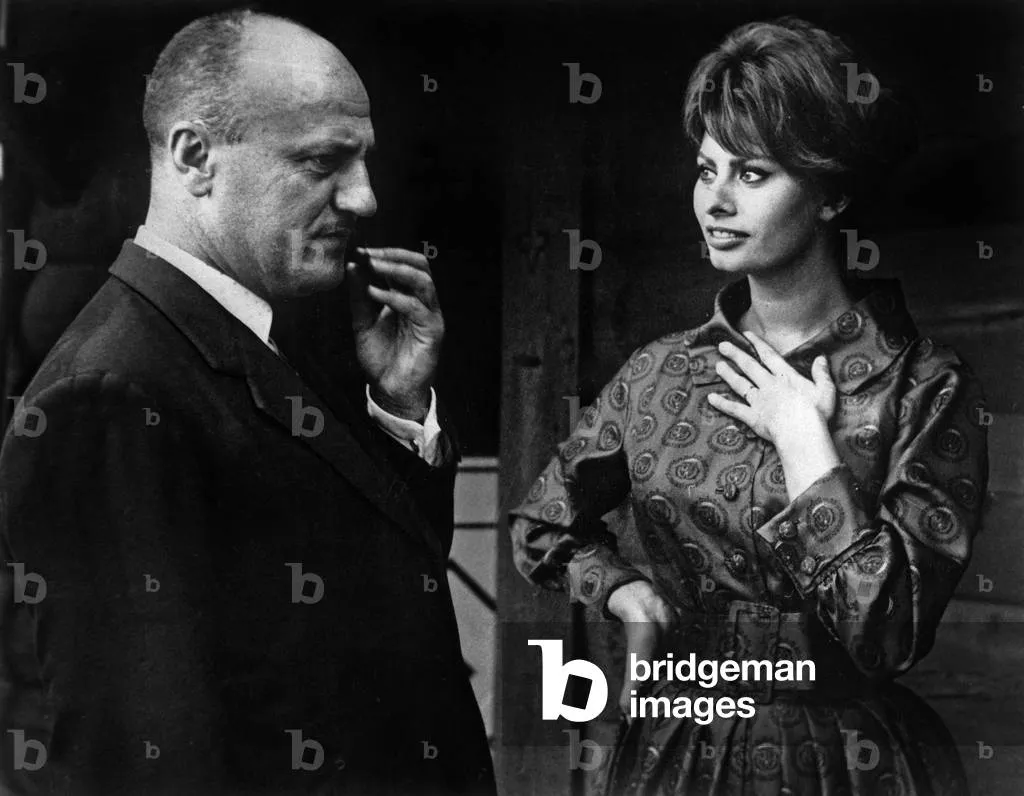
Sophia Loren & Pierre Balmain photo/bridgemanimages
Signature Accessories and Perfumes
In addition to his couture creations, Pierre Balmain ventured into accessories and fragrances, leaving an indelible mark on these domains. The launch of his perfume “Vent Vert” in 1947 was groundbreaking, as it introduced a fresh, green scent that was revolutionary at the time. His accessories, from chic handbags to statement jewelry, complemented his clothing designs, allowing women to embrace Balmain’s world of luxury in its entirety.
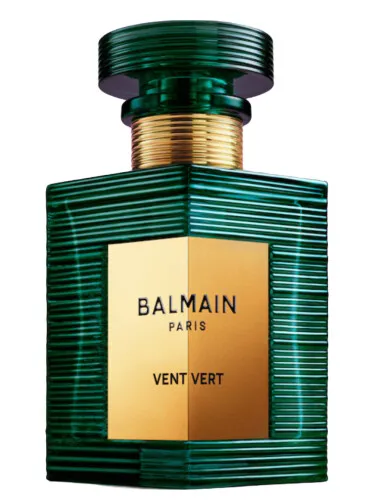
photo/fragrantica
Also Read-Breaking Down Jacques Fath’s Signature Style: What Made Him a Legend
Pierre Balmain’s Influence on Haute Couture
Contribution to French Haute Couture: Pierre Balmain was instrumental in re-establishing Paris as the global capital of haute couture after the devastation of World War II. His designs epitomized French luxury, with each garment embodying precision, artistry, and sophistication. Balmain’s creations were not just clothes; they were masterpieces that elevated the wearer’s status and confidence.
Influence on International Fashion: Balmain’s influence extended far beyond France. Hollywood’s elite, including Ava Gardner, Katharine Hepburn, and Brigitte Bardot, embraced his designs, wearing them for both red-carpet events and private occasions. His creations became synonymous with glamour, making him a household name among international audiences. Balmain’s ability to blend Parisian elegance with global appeal cemented his legacy as a designer of unparalleled influence.
Collaborations in the Film Industry: Balmain’s flair for drama and beauty naturally drew him to the film industry. He designed costumes for iconic movies such as And God Created Woman, starring Brigitte Bardot, and La Parisienne. His work brought a sense of couture luxury to the silver screen, enhancing characters’ personalities and adding visual opulence to the films. These collaborations further solidified his global reputation, bridging the gap between fashion and cinema.
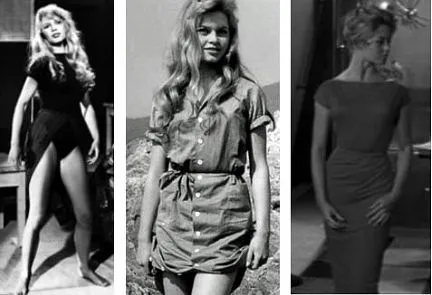
God created woman costume/photo/pinterest
The Leadership Transition
Pierre Balmain’s Passing
Pierre Balmain passed away in 1982, leaving behind a fashion empire synonymous with elegance and innovation. His death marked the end of an era, but his vision lived on through the dedicated individuals who carried his legacy forward. The transition was challenging, but it also provided an opportunity to honor his work while adapting to changing times.
Leadership Under Erik Mortensen
Erik Mortensen, Balmain’s trusted assistant and protégé, took over the reins as creative director after his mentor’s passing. Mortensen’s leadership maintained the brand’s core values, producing collections that resonated with Balmain’s original ethos. His work earned critical acclaim, including two Golden Thimbles, the highest honor in French couture.

photo/moda.mam-e
The Modern Era Under Olivier Rousteing
Olivier Rousteing’s appointment as creative director in 2011 marked a new chapter for Balmain. With his keen understanding of contemporary fashion, Rousteing redefined the brand for a younger audience. He introduced bold designs, modern cuts, and an emphasis on diversity, making Balmain a favorite among celebrities like Rihanna, Beyoncé, and Kim Kardashian. Despite the modern twist, Rousteing remained committed to preserving the timeless elegance that defined Pierre Balmain’s original vision.

photo/snl24
The Legacy of Pierre Balmain Today
Today, Balmain stands as a testament to Pierre Balmain’s genius. The brand seamlessly combines its rich heritage with modern innovation, offering collections that appeal to diverse audiences. From haute couture to ready-to-wear lines, Balmain continues to embody the elegance, artistry, and luxury that its founder envisioned.
Why Pierre Balmain’s Work is Timeless
Balmain’s work transcends trends because it is rooted in principles of beauty and sophistication. His mastery of fabric, his attention to detail, and his dedication to celebrating the female form have ensured that his designs remain relevant and desirable. Each creation is a blend of artistry and functionality, appealing to fashion enthusiasts across generations.
Interesting Facts About Pierre Balmain
- Pierre Balmain referred to his creations as “architecture for the movement”.
- He designed uniforms for airlines and even a sports team, showcasing his diverse design capabilities.
- Balmain authored a memoir titled My Years and Seasons, offering a glimpse into his fascinating journey in fashion.
- Balmain was close friends with Christian Dior, and the two worked together under Lucien Lelong before establishing their respective fashion houses.
- He was one of the first designers to dress international royalty, including Queen Sirikit of Thailand.
- His sketches often resembled intricate artworks, reflecting his architectural background and artistic eye.
Challenges
Despite his success, Balmain faced several challenges throughout his career. Launching a fashion house in post-war Europe was no easy feat, as economic instability and material shortages posed significant obstacles. However, Balmain’s determination and vision enabled him to navigate these difficulties and establish a thriving business.
Cultural shifts in fashion, such as the rise of ready-to-wear collections, also tested Balmain’s adaptability. Nevertheless, his ability to innovate ensured his relevance even in changing times.
Pierre Balmain at a Glance
| Category | Details |
|---|---|
| Name | Pierre Balmain |
| Born | May 18, 1914, in Saint-Jean-de-Maurienne, France |
| Parents | Father: Drapery business owner; Mother: Fashion boutique manager |
| Initial Career Path | Studied architecture at École des Beaux-Arts, Paris |
| Fashion Career Start | Worked under Edward Molyneux before founding Maison Balmain in 1945 |
| Founding of Maison Balmain | Established in 1945; aimed to redefine post-war fashion with elegance and femininity |
| Signature Style | “Jolie Madame” featuring tailored jackets, cinched waists, and flowing skirts |
| Notable Clients | Queen Sirikit of Thailand, Ava Gardner, Marlene Dietrich, Sophia Loren, Katharine Hepburn, Brigitte Bardot |
| Hollywood Impact | Designed costumes for films like And God Created Woman and La Parisienne |
| Fragrance Legacy | Introduced iconic perfumes like “Vent Vert” in 1947 |
| Design Philosophy | Rooted in timeless elegance, focusing on clean lines, luxurious fabrics, and minimal embellishments |
| Challenges | Navigating post-war economic struggles and adapting to shifts like the rise of ready-to-wear fashion |
| Leadership Transition | After his passing in 1982, Erik Mortensen succeeded him, followed by modern leadership under Olivier Rousteing |
| Olivier Rousteing’s Role | Modernized the brand, introduced bold, edgy designs, and emphasized diversity while maintaining Balmain’s legacy |
| Interesting Facts | – Close friends with Christian Dior; worked under Lucien Lelong together.- Designed uniforms for airlines and sports teams.- Authored memoir My Years and Seasons. |
| Awards | Erik Mortensen won two Golden Thimbles under Balmain’s leadership. |
| Legacy | Continues to influence global fashion with a blend of tradition and innovation |
| Relevance Today | Balmain appeals to a diverse audience, combining haute couture with ready-to-wear and maintaining luxury standards |
Conclusion
Pierre Balmain was more than a designer; he was a visionary who redefined fashion for the modern woman. His legacy endures through the creations of his fashion house, which continues to honor his principles while embracing the future. Balmain’s journey from a small Alpine town to global recognition is a testament to the power of creativity, determination, and an unwavering commitment to excellence.
FAQs
What is Pierre Balmain best known for?
Pierre Balmain is best known for his elegant “Jolie Madame” style and his pioneering contributions to haute couture.
How did Pierre Balmain revolutionize fashion?
He introduced a post-war aesthetic that celebrated femininity and grace, offering women a renewed sense of beauty and sophistication.
What is the signature style of Balmain?
Balmain’s signature style features structured silhouettes, intricate embroidery, and an emphasis on timeless elegance.
Who leads Balmain today?
Olivier Rousteing is the current creative director, blending contemporary trends with Balmain’s rich heritage.
Why is Balmain still relevant in modern fashion?
Balmain’s ability to evolve while maintaining its core identity has kept it at the forefront of global fashion.
One thought on “The Pierre Balmain Legacy: French Fashion’s Crown Jewel”